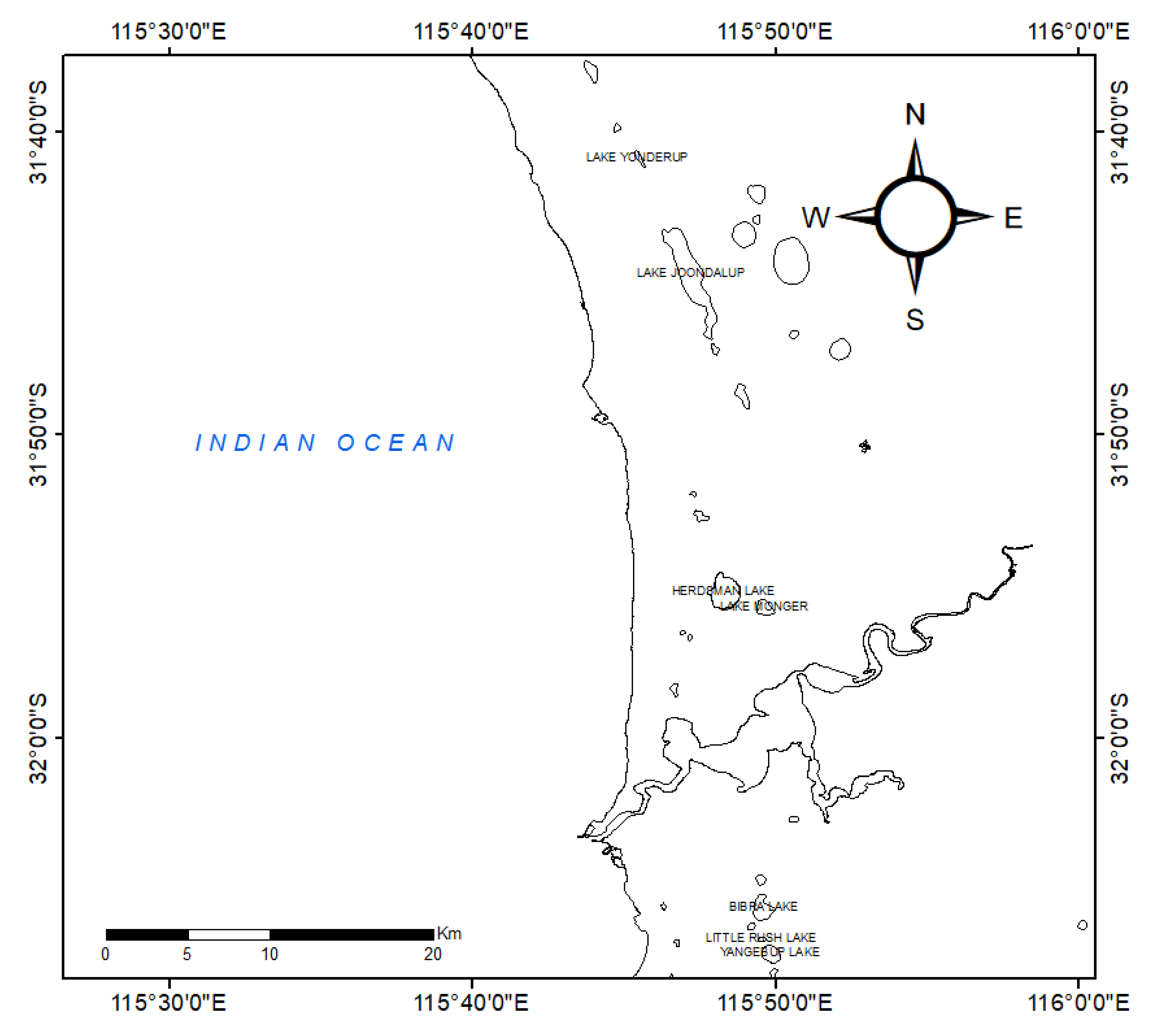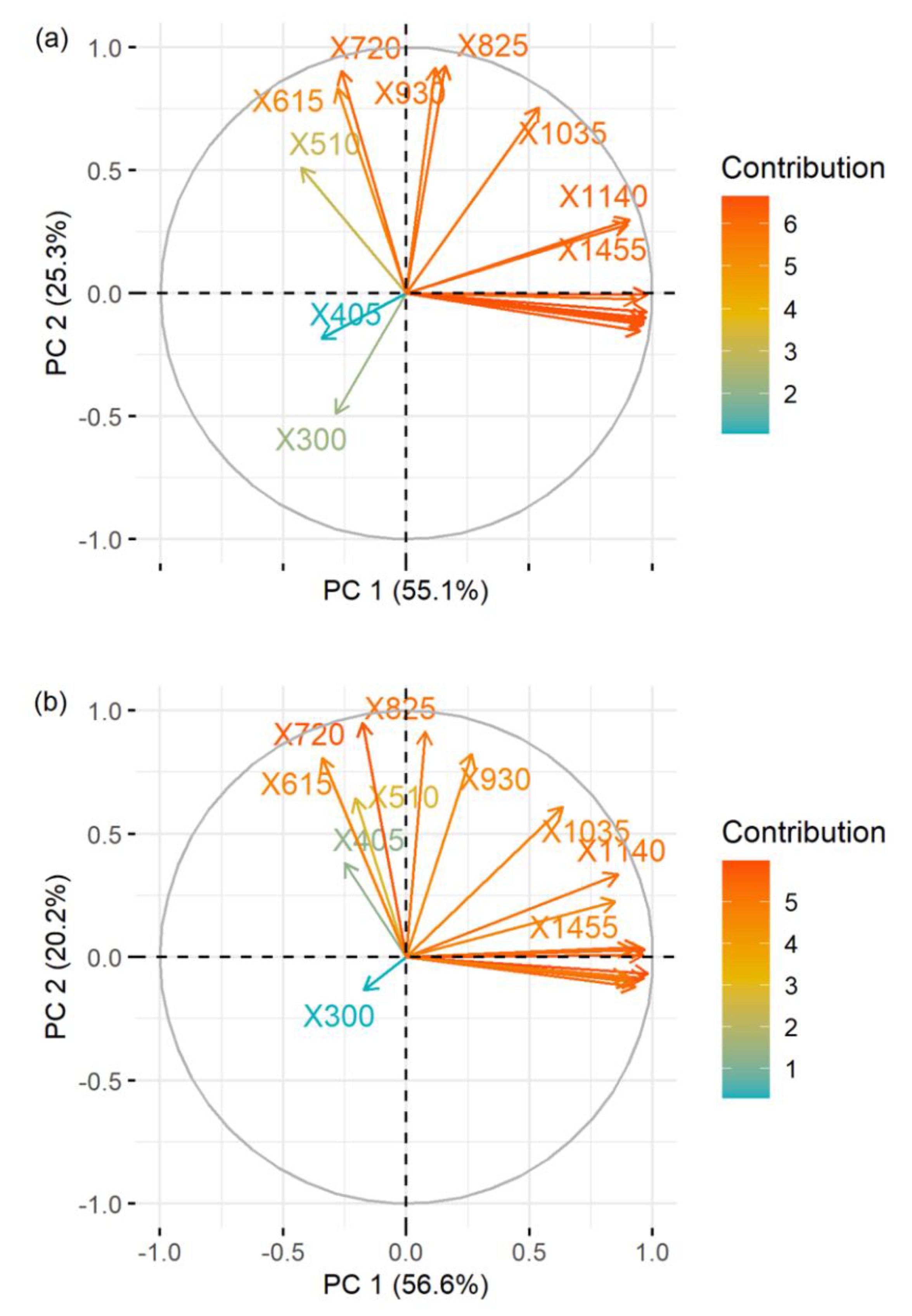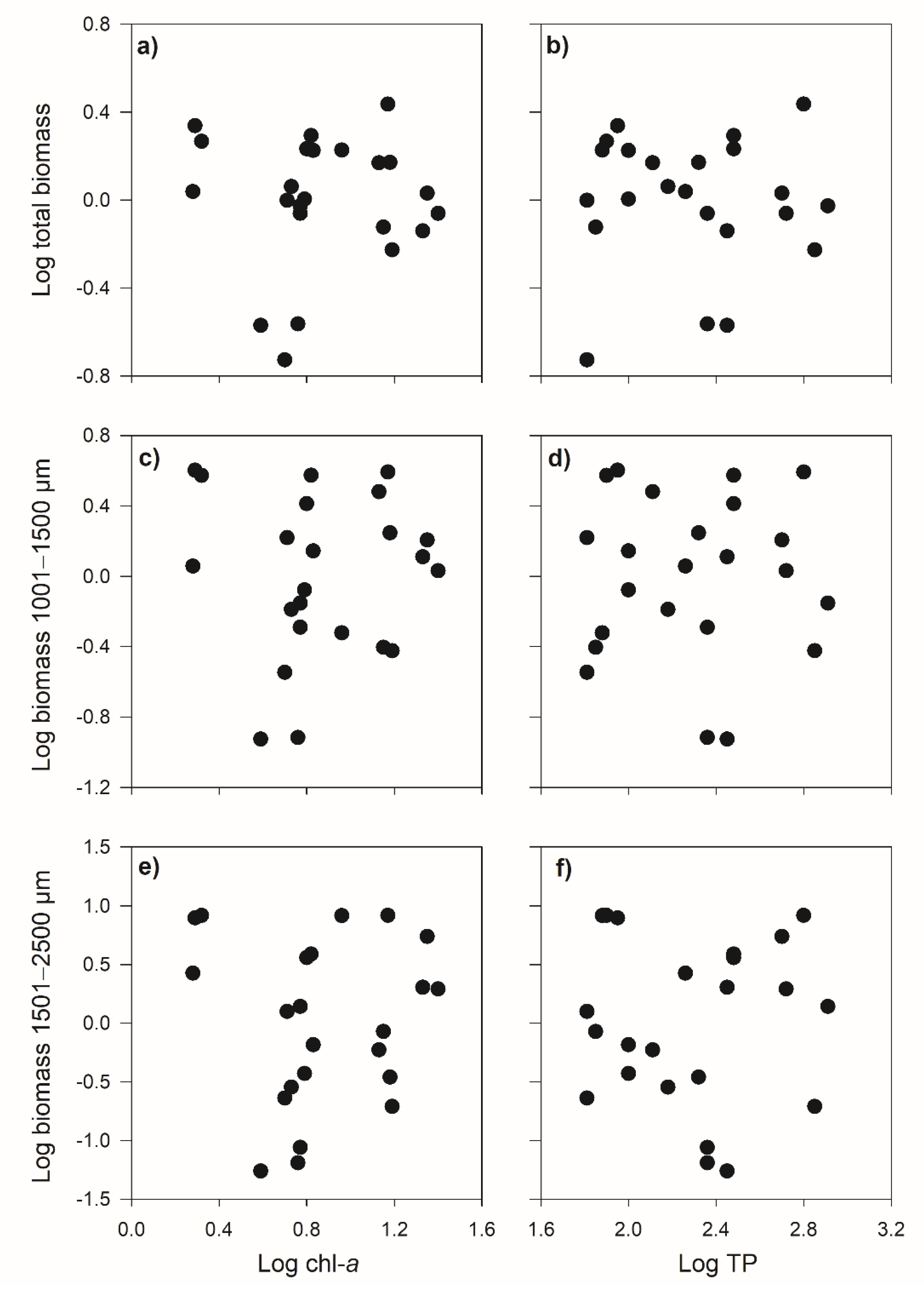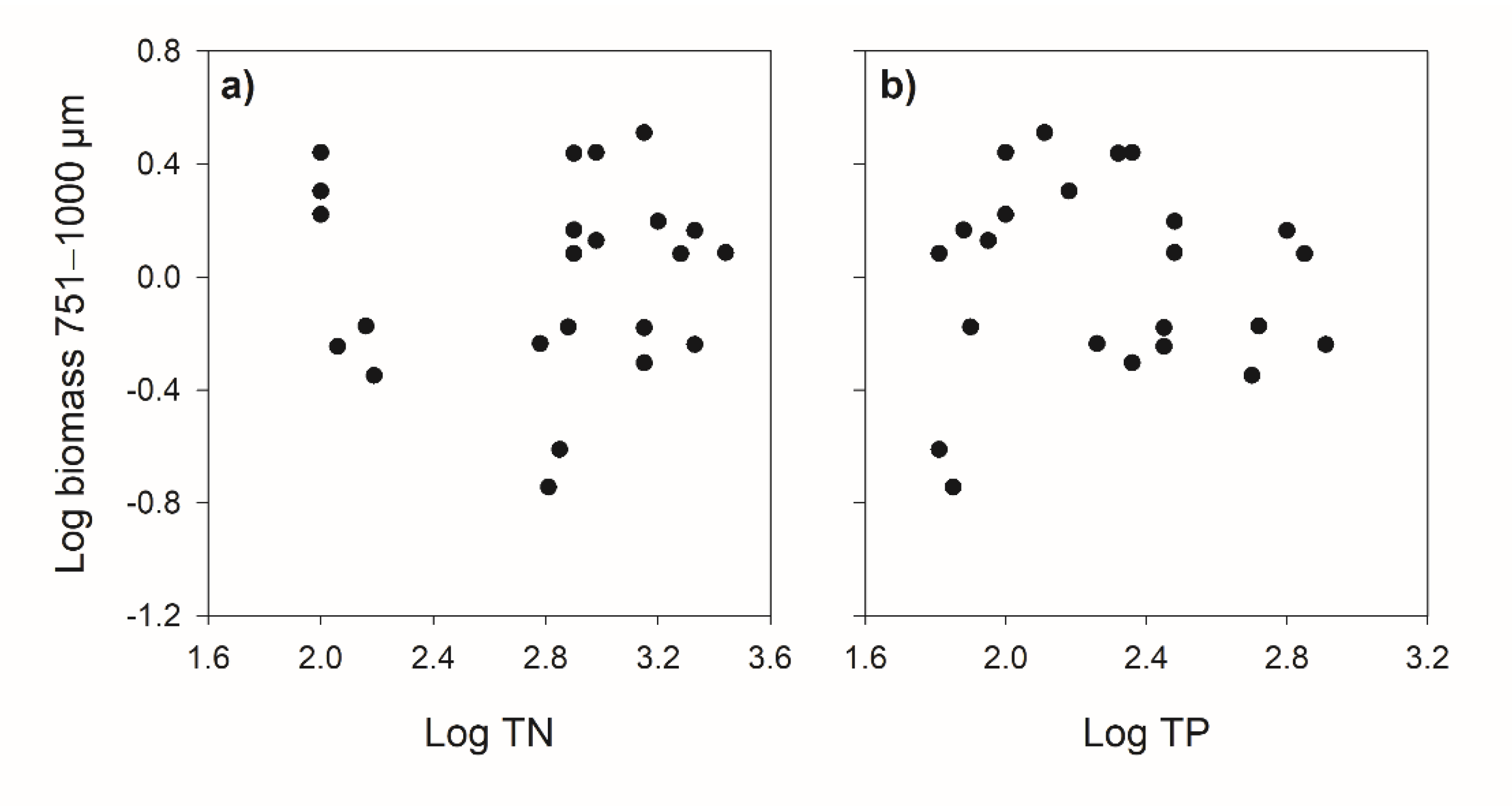Response of Zooplankton Size Structure to Multiple Stressors in Urban Lakes
Abstract
:1. Introduction
2. Materials and Methods
2.1. Study Areas
2.2. Sampling and Analysis
2.3. LOPC Calibration
2.4. Zooplankton Density and Biomass
2.5. Normalised Biomass Size Spectra
2.6. Statistical Analysis
3. Results
3.1. General Environmental Characteristics
3.2. LOPC Validation
3.3. Community Structure
3.4. Normalised Biomass Size Spectra (NBSS)
3.5. Environmental Variables Affecting Zooplankton Community Structure
4. Discussion
4.1. Environmental Factors Regulating Zooplankton Community Size Structure
4.2. Zooplankton Functional Classification Relative to Size Structure
5. Conclusions
Author Contributions
Funding
Data Availability Statement
Acknowledgments
Conflicts of Interest
References
- United Nations, Department of Economic and Social Affairs, Population Division. World Urbanization Prospects: The 2018 Revision (ST/ESA/SER.A/420); United Nations: New York, NY, USA, 2019. [Google Scholar]
- Seto, K.C.; Güneralp, B.; Hutyra, L.R. Global forecasts of urban expansion to 2030 and direct impacts on biodiversity and carbon pools. Proc. Natl. Acad. Sci. USA 2012, 109, 16083–16088. [Google Scholar] [CrossRef] [Green Version]
- Seto, K.C.; Parnell, S.; Elmqvist, T. A Global Outlook on Urbanization. In Urbanization, Biodiversity and Ecosystem Services: Challenges and Opportunities; Elmqvist, T., Fragkias, M., Goodness, J., Güneralp, B., Marcotullio, P.J., McDonald, R.I., Parnell, S., Schewenius, M., Sendstad, M., Seto, K.C., et al., Eds.; Springer: Berlin/Heidelberg, Germany, 2013; pp. 1–12. [Google Scholar]
- Güneralp, B.; Reba, M.; Hales, B.U.; Wentz, E.A.; Seto, K.C. Trends in urban land expansion, density, and land transitions from 1970 to 2010: A global synthesis. Environ. Res. Lett. 2020, 15, 044015. [Google Scholar] [CrossRef]
- United Nations. Transforming Our World: The 2030 Agenda for Sustainable Development; United Nations: New York, NY, USA, 2015. [Google Scholar]
- Meyer, J.L.; Likens, G.E. Urban Aquatic Ecosystems. In Encyclopedia of Inland Waters; Academic Press: Oxford, UK, 2009; pp. 367–377. [Google Scholar]
- Boone, C.G.; Cook, E.; Hall, S.; Nation, M.L.; Grimm, N.B.; Raish, C.B.; Finch, D.M.; York, A.M. A comparative gradient approach as a tool for understanding and managing urban ecosystems. Urban. Ecosyst. 2012, 15, 795–807. [Google Scholar] [CrossRef]
- Adrian, R.; O’Reilly, C.M.; Zagarese, H.; Baines, S.B.; Hessen, D.O.; Keller, W.; Livingstone, D.M.; Sommaruga, R.; Straile, D.; van Donk, E.; et al. Lakes as sentinels of climate change. Limnol. Oceanogr. 2009, 54, 2283–2297. [Google Scholar] [CrossRef]
- Williamson, C.E.; Saros, J.E.; Vincent, W.; Smol, J. Lakes and reservoirs as sentinels, integrators, and regulators of climate change. Limnol. Oceanogr. 2009, 54, 2273–2282. [Google Scholar] [CrossRef]
- Sinang, S.C.; Reichwaldt, E.; Ghadouani, A. Local nutrient regimes determine site-specific environmental triggers of cyanobacterial and microcystin variability in urban lakes. Hydrol. Earth Syst. Sci. 2015, 19, 2179–2195. [Google Scholar] [CrossRef] [Green Version]
- Li, Y.; Xie, P.; Zhao, D.; Zhu, T.; Guo, L.; Zhang, J. Eutrophication strengthens the response of zooplankton to temperature changes in a high-altitude lake. Ecol. Evol. 2016, 6, 6690–6701. [Google Scholar] [CrossRef]
- Rosset, V.; Angélibert, S.; Arthaud, F.; Bornette, G.; Robin, J.; Wezel, A.; Vallod, D.; Oertli, B. Is eutrophication really a major impairment for small waterbody biodiversity? J. Appl. Ecol. 2014, 51, 415–425. [Google Scholar] [CrossRef]
- Strayer, D.; Dudgeon, D. Freshwater biodiversity conservation: Recent progress and future challenges. J. North. Am. Benthol. Soc. 2010, 29, 344–358. [Google Scholar] [CrossRef] [Green Version]
- Persson, J. Urban Lakes And Ponds. In Encyclopedia of Lakes and Reservoirs; Bengtsson, L., Herschy, R.W., Fairbridge, R.W., Eds.; Springer: Dordrecht, The Netherlands, 2012; pp. 836–839. [Google Scholar]
- Pickett, S.T.A.; Zhou, W. Global urbanization as a shifting context for applying ecological science toward the sustainable city. Ecosyst. Health Sustain. 2015, 1, 1–15. [Google Scholar] [CrossRef]
- Liu, Y. Dynamic evaluation on ecosystem service values of urban rivers and lakes: A case study of Nanchang City, China. Aquat. Ecosyst. Health Manag. 2014, 17, 161–170. [Google Scholar] [CrossRef]
- Chester, E.; Robson, B. Anthropogenic refuges for freshwater biodiversity: Their ecological characteristics and management. Biol. Conserv. 2013, 166, 64–75. [Google Scholar] [CrossRef]
- Vermonden, K.; Leuven, R.S.; van der Velde, G.; van Katwijk, M.M.; Roelofs, J.G.; Hendriks, A.J. Urban drainage systems: An undervalued habitat for aquatic macroinvertebrates. Biol. Conserv. 2009, 142, 1105–1115. [Google Scholar] [CrossRef]
- Davies, P.M.; Stewart, B.A. Aquatic biodiversity in the Mediterranean climate rivers of southwestern Australia. Hydrobiologia 2013, 719, 215–235. [Google Scholar] [CrossRef]
- Pinel-Alloul, B.; Mimouni, E.-A. Are cladoceran diversity and community structure linked to spatial heterogeneity in urban landscapes and pond environments? Hydrobiologia 2013, 715, 195–212. [Google Scholar] [CrossRef]
- Noble, A.; Hassall, C. Poor ecological quality of urban ponds in northern England: Causes and consequences [dataset]. Urban. Ecosyst. 2014, 18, 649–662. [Google Scholar] [CrossRef]
- Barbosa, A.; Fernandes, J.; David, L.M. Key issues for sustainable urban stormwater management. Water Res. 2012, 46, 6787–6798. [Google Scholar] [CrossRef] [PubMed]
- Foley, J.A.; DeFries, R.; Asner, G.P.; Barford, C.; Bonan, G.; Carpenter, S.R.; Chapin, F.S.; Coe, M.T.; Daily, G.C.; Gibbs, H.K.; et al. Global Consequences of Land Use. Science 2005, 309, 570–574. [Google Scholar] [CrossRef] [Green Version]
- Grimm, N.B.; Foster, D.; Groffman, P.; Grove, J.M.; Hopkinson, C.S.; Nadelhoffer, K.J.; Pataki, D.E.; Peters, D.P. The changing landscape: Ecosystem responses to urbanization and pollution across climatic and societal gradients. Front. Ecol. Environ. 2008, 6, 264–272. [Google Scholar] [CrossRef] [Green Version]
- Van Egeren, S.J.; Dodson, S.I.; Torke, B.; Maxted, J.T. The relative significance of environmental and anthropogenic factors affecting zooplankton community structure in Southeast Wisconsin Till Plain lakes. Hydrobiologia 2011, 668, 137–146. [Google Scholar] [CrossRef]
- Jeppesen, E.; Nõges, P.; Davidson, T.; Haberman, J.; Nõges, T.; Blank, K.; Lauridsen, T.; Søndergaard, M.; Sayer, C.; Laugaste, R.; et al. Zooplankton as indicators in lakes: A scientific-based plea for including zooplankton in the ecological quality assessment of lakes according to the European Water Framework Directive (WFD). Hydrobiologia 2011, 676, 279–297. [Google Scholar] [CrossRef]
- Dodson, S.I.; Newman, A.L.; Will-Wolf, S.; Alexander, M.L.; Woodford, M.P.; Van Egeren, S. The relationship between zooplankton community structure and lake characteristics in temperate lakes (Northern Wisconsin, USA). J. Plankton Res. 2008, 31, 93–100. [Google Scholar] [CrossRef] [Green Version]
- Ghadouani, A.; Pinel-Alloul, B.; Prepas, E.E. Could increased cyanobacterial biomass following forest harvesting cause a reduction in zooplankton body size structure? Can. J. Fish. Aquat. Sci. 2006, 63, 2308–2317. [Google Scholar] [CrossRef]
- Litchman, E.; Ohman, M.D.; Kiørboe, T. Trait-based approaches to zooplankton communities. J. Plankton Res. 2013, 35, 473–484. [Google Scholar] [CrossRef] [Green Version]
- Boven, L.; Brendonck, L. Impact of hydroperiod on seasonal dynamics in temporary pool cladoceran communities. Fundam. Appl. Limnol. 2009, 174, 147–157. [Google Scholar] [CrossRef]
- Ersoy, Z.; Jeppesen, E.; Sgarzi, S.; Arranz, I.; Cañedo-Argüelles, M.; Quintana, X.D.; Landkildehus, F.; Lauridsen, T.L.; Bartrons, M.; Brucet, S. Size-based interactions and trophic transfer efficiency are modified by fish predation and cyanobacteria blooms in Lake Mývatn, Iceland. Freshw. Biol. 2017, 62, 1942–1952. [Google Scholar]
- Hoffmann, M.D.; Dodson, S.I. Land use, Primary Productivity, and lake area as descriptors of zooplankton diversity. Ecology 2005, 86, 255–261. [Google Scholar] [CrossRef]
- Brans, K.I.; De Meester, L. City life on fast lanes: Urbanization induces an evolutionary shift towards a faster lifestyle in the water flea Daphnia. Funct. Ecol. 2018, 32, 2225–2240. [Google Scholar] [CrossRef]
- Zhao, C.; Liu, C.; Zhao, J.; Xia, J.; Yu, Q.; Eamus, D. Zooplankton in highly regulated rivers: Changing with water environment. Ecol. Eng. 2013, 58, 323–334. [Google Scholar] [CrossRef]
- Ye, L.; Chang, C.-Y.; García-Comas, C.; Gong, G.-C.; Hsieh, C.-H. Increasing zooplankton size diversity enhances the strength of top-down control on phytoplankton through diet niche partitioning. J. Anim. Ecol. 2013, 82, 1052–1061. [Google Scholar] [CrossRef]
- Quintana, X.D.; Brucet, S.; Boix, D.; López-Flores, R.; Gascón, S.; Badosa, A.; Sala, J.; Moreno-Amich, R.; Egozcue, J.J. A nonparametric method for the measurement of size diversity with emphasis on data standardization. Limnol. Oceanogr. Methods 2008, 6, 75–86. [Google Scholar] [CrossRef] [Green Version]
- Kerr, S.R.; Dickie, L.M. The Biomass Spectrum: A Predatort-Prey Theory of Aquatic Production; Cloumbia University Press: New York, UY, USA, 2001. [Google Scholar]
- Schmidt, D.N.; Lazarus, D.; Young, J.R.; Kucera, M. Biogeography and evolution of body size in marine plankton. Earth Sci Rev. 2006, 78, 239–266. [Google Scholar] [CrossRef]
- Bonner, N.; Peters, R.H. The Ecological Implications of Body Size. J. Appl. Ecol. 1985, 22, 291. [Google Scholar] [CrossRef]
- Hébert, M.-P.; Beisner, B.; Maranger, R. Linking zooplankton communities to ecosystem functioning: Toward an effect-trait framework. J. Plankton Res. 2017, 39, 3–12. [Google Scholar] [CrossRef] [Green Version]
- de Eyto, E.; Irvine, K. Assessing the status of shallow lakes using an additive model of biomass size spectra. Aquat. Conserv. Mar. Freshw. Ecosyst. 2007, 17, 724–736. [Google Scholar] [CrossRef]
- Yamaguchi, A.; Matsuno, K.; Abe, Y.; Arima, D.; Ohgi, K. Seasonal changes in zooplankton abundance, biomass, size structure and dominant copepods in the Oyashio region analysed by an optical plankton counter. Deep. Sea Res. Part. I Oceanogr. Res. Pap. 2014, 91, 115–124. [Google Scholar] [CrossRef] [Green Version]
- Ghadouani, A.; Pinel-Alloul, B.; Prepas, E.E. Effects of experimentally induced cyanobacterial blooms on crustacean zooplankton communities. Freshw. Biol. 2003, 48, 363–381. [Google Scholar] [CrossRef]
- Oberhaus, L.; Gélinas, M.; Pinel-Alloul, B.; Ghadouani, A.; Humbert, J.-F. Grazing of two toxic Planktothrix species by Daphnia pulicaria: Potential for bloom control and transfer of microcystins. J. Plankton Res. 2007, 29, 827–838. [Google Scholar] [CrossRef] [Green Version]
- Reichwaldt, E.S.; Ghadouani, A. Effects of rainfall patterns on toxic cyanobacterial blooms in a changing climate: Between simplistic scenarios and complex dynamics. Water Res. 2012, 46, 1372–1393. [Google Scholar] [CrossRef] [PubMed]
- Datta, S.; Blanchard, J. The effects of seasonal processes on size spectrum dynamics. Can. J. Fish. Aquat. Sci. 2016, 73, 598–610. [Google Scholar] [CrossRef] [Green Version]
- Mines, C.H.; Ghadouani, A.; Legendre, P.; Yan, N.; Ivey, G. Examining shifts in zooplankton community variability following biological invasion. Limnol. Oceanogr. 2013, 58, 399–408. [Google Scholar] [CrossRef] [Green Version]
- Zhang, J.; Xie, P.; Tao, M.; Guo, L.; Chen, J.; Li, L.; Zhang, X.; Zhang, L. The Impact of Fish Predation and Cyanobacteria on Zooplankton Size Structure in 96 Subtropical Lakes. PLoS ONE 2013, 8, e76378. [Google Scholar] [CrossRef] [Green Version]
- Horwitz, P.; Bradshaw, D.; Hopper, S.; Davies, P.; Froend, R.; Bradshaw, F. Hydrological change escalates risk of ecosystem stress in Australia’s threatened biodiversity hotspot. J. R. Soc. West. Aust. 2008, 91, 1–11. [Google Scholar]
- Davis, J.A.; Rosich, R.S. Wetlands of the Swan Coastal Plain. In Wetlands of the Swan Coastal Plain; Davis, J.A., Rosich, R.S., Bradley, J.S., Growns, J.E., Schimdt, L.G., Cheal, F., Eds.; Water Authority of Western Australia: Perth, Australia, 1993; Volume 6. [Google Scholar]
- Bureau of Meteorology (BOM). Climate Data Online. 2021. Available online: http://www.bom.gov.au/climate/data/ (accessed on 26 May 2021).
- American Public Health Association (APHA). Standard Methods for the Examination of Water and Wastewater; General Books LLC: Memphis, TN, USA, 2013. [Google Scholar]
- Zhou, L.; Huang, L.; Tan, Y.; Lian, X.; Li, K. Size-based analysis of a zooplankton community under the influence of the Pearl River plume and coastal upwelling in the northeastern South China Sea. Mar. Biol. Res. 2014, 11, 168–179. [Google Scholar] [CrossRef]
- Beaulieu, S.E.; Mullin, M.M.; Tang, V.T.; Pyne, S.M.; King, A.L.; Twinning, B.S. Using an optical plankton counter to determine the size distributions of preserved zooplankton samples. J. Plankton Res. 1999, 21, 1939–1956. [Google Scholar] [CrossRef] [Green Version]
- Yang, X.-E.; Wu, X.; Hao, H.-L.; He, Z.-L. Mechanisms and assessment of water eutrophication. J. Zhejiang Univ. Sci. B 2008, 9, 197–209. [Google Scholar] [CrossRef]
- García-Chicote, J.; Armengol, X.; Rojo, C. Zooplankton species as indicators of trophic state in reservoirs from Mediterranean river basins. Inland Waters 2019, 9, 113–123. [Google Scholar] [CrossRef]
- Finlay, K.; Beisner, B.E.; Patoine, A.; Pinel-Alloul, B. Regional ecosystem variability drives the relative importance of bottom-up and top-down factors for zooplankton size spectra. Can. J. Fish. Aquat. Sci. 2007, 64, 516–529. [Google Scholar] [CrossRef] [Green Version]
- Mimouni, E.-A.; Pinel-Alloul, B.; Beisner, B.E. Assessing aquatic biodiversity of zooplankton communities in an urban landscape. Urban. Ecosyst. 2015, 18, 1353–1372. [Google Scholar] [CrossRef]
- Yurista, P.M.; Yule, D.L.; Balge, M.; VanAlstine, J.D.; Thompson, J.A.; Gamble, A.E.; Hrabik, T.R.; Kelly, J.R.; Stockwell, J.D.; Vinson, M.R. A new look at the Lake Superior biomass size spectrum. Can. J. Fish. Aquat. Sci. 2014, 71, 1324–1333. [Google Scholar] [CrossRef]
- Masson, S.; Pinel-Alloul, B.; Smith, V.H. Total phosphorus-chlorophyll a size fraction relationships in southern Québec lakes. Limnol. Oceanogr. 2000, 45, 732–740. [Google Scholar] [CrossRef]
- Watson, S.; McCauley, E.; Downing, J.A. Sigmoid Relationships between Phosphorus, Algal Biomass, and Algal Community Structure. Can. J. Fish. Aquat. Sci. 1992, 49, 2605–2610. [Google Scholar] [CrossRef]
- Sinang, S.C.; Reichwaldt, E.; Ghadouani, A. Spatial and temporal variability in the relationship between cyanobacterial biomass and microcystins. Environ. Monit. Assess. 2012, 185, 6379–6395. [Google Scholar] [CrossRef] [PubMed]
- Hansen, B.; Hansen, P.J.; Nielsen, T.G. Effects of large nongrazable particles on clearance and swimming behaviour of zooplankton. J. Exp. Mar. Biol. Ecol. 1991, 152, 257–269. [Google Scholar] [CrossRef]
- Gamble, A.E.; Lloyd, R.; Aiken, J.; Johannsson, O.E.; Mills, E.L. Using zooplankton biomass size spectra to assess ecological change in a well-studied freshwater lake ecosystem: Oneida Lake, New York. Can. J. Fish. Aquat. Sci. 2006, 63, 2687–2699. [Google Scholar] [CrossRef]
- Ghadouani, A.; Pinel-Alloul, B.; Plath, K.; Codd, G.A.; Lampert, W. Effects of Microcystis aeruginosa and purified microcystin-LR on the feeding behavior of Daphnia pulicaria. Limnol. Oceanogr. 2004, 49, 666–679. [Google Scholar] [CrossRef]
- Jeppesen, E.; Lauridsen, T.; Mitchell, S.F.; Burns, C.W. Do planktivorous fish structure the zooplankton communities in New Zealand lakes? N. Z. J. Mar. Freshw. Res. 1997, 31, 163–173. [Google Scholar] [CrossRef]
- Dodson, S.I. Zooplankton Competition and Predation: An Experimental Test of the Size-Efficiency Hypothesis. Ecology 1974, 55, 605–613. [Google Scholar] [CrossRef]
- William Gary, S.; Lauren Emily, B.; Henrique, G. Surfing the biomass size spectrum: Some remarks on history, theory, and application. Can. J. Fish. Aquat. Sci. 2016, 73, 477–495. [Google Scholar]
- Zhou, M. What determines the slope of a plankton biomass spectrum? J. Plankton Res. 2006, 28, 437–448. [Google Scholar] [CrossRef]
- Sprules, W.G.; Munawar, M. Plankton Size Spectra in Relation to Ecosystem Productivity, Size, and Perturbation. Can. J. Fish. Aquat. Sci. 1986, 43, 1789–1794. [Google Scholar] [CrossRef]
- Gaedke, U.; Seifried, A.; Adrian, R. Biomass Size Spectra and Plankton Diversity in a Shallow Eutrophic Lake. Int. Rev. Hydrobiol. 2004, 89, 1–20. [Google Scholar] [CrossRef]
- Vogt, R.J.; Peres-Neto, P.R.; Beisner, B. Using functional traits to investigate the determinants of crustacean zooplankton community structure. Oikos 2013, 122, 1700–1709. [Google Scholar] [CrossRef]
- Pitois, S.G.; Fox, C.J. Long-term changes in zooplankton biomass concentration and mean size over the Northwest European shelf inferred from Continuous Plankton Recorder data. ICES J. Mar. Sci. 2006, 63, 785–798. [Google Scholar] [CrossRef]
- Ma, C.; Mwagona, P.C.; Yu, H.; Sun, X.; Liang, L.; Mahboob, S.; Al-Ghanim, K.A. Seasonal dynamics of zooplankton functional group and its relationship with physico-chemical variables in high turbid nutrient-rich Small Xingkai Wetland Lake, Northeast China. J. Freshw. Ecol. 2019, 34, 65–79. [Google Scholar] [CrossRef] [Green Version]









| Lake Name | Classification/Category | Area (km2) | Open Water (km2) | Urban Density | Potential Disturbances |
|---|---|---|---|---|---|
| Yangebup | Nature Reserve | 0.83 | 0.83 | Low | Industrial and urban waste |
| Little Rush | Nature Reserve | 0.09 | 0.05 | Low | Horticultural area |
| Bibra | Regional Park | 0.96 | 0.95 | Medium | Residential, golf course and urban development |
| Herdsman | Park and Recreation | 2.35 | 0.71 | High | Urban, commercial, industry and stormwater |
| Monger | Park and Recreation | 0.72 | 0.71 | High | Stormwater flow into the lakes, residential and urban development |
| Joondalup | Nature Reserve | 4.99 | 4.55 | Medium | Residential, recreational area and agriculture |
| Yonderup | Nature Reserve | 0.012 | 0.0057 | Low | Road development, bush fire |
| Variable | Mean | Minimum | Maximum | SD | One-Way ANOVA |
|---|---|---|---|---|---|
| Open water area (km2) | 1.12 | 0.0057 | 4.55 | 1.54 | Not applicable |
| Secchi depth (m) | 0.71 | 0.50 | 0.90 | 1.20 | F(6,22) = 25.59; p < 0.001 |
| Average water depth (m) | 1.24 | 0.80 | 2.20 | 1.24 | F(6,22) = 16.42; p < 0.001 |
| Temperature (°C) | 22.3 | 20.3 | 24.2 | 0.50 | F(6,22) = 281.31; p < 0.001 |
| Conductivity (mS cm−1) | 1.37 | 0.74 | 2.17 | 0.47 | F(6,22) = 1583.85; p < 0.001 |
| Salinity (ppm) | 631 | 315 | 1416 | 75.7 | F(6,22) = 86.50: p < 0.001 |
| Suspended solids (mg L−1) | 8.23 | 6.80 | 23.0 | 4.79 | F(6,22) = 3.67; p = 0.02 |
| pH | 7.15 | 7.16 | 8.09 | 7.87 | F(6,22) = 1.32; p = 0.30 |
| Dissolved oxygen (mg L−1) | 7.84 | 5.21 | 17.8 | 2.71 | F(6,22) = 2.70; p = 0.052 |
| Total nitrogen (mg L−1) | 0.98 | 0.10 | 2.75 | 0.75 | F(6,22) = 69.38, p < 0.001 |
| Total phosphate (mg L−1) | 0.27 | 0.21 | 0.81 | 0.22 | F(6,22) = 30.84; p < 0.001 |
| Chlorophyll-a (µg L−1) | 9.55 | 1.92 | 24.9 | 0.68 | F(6,22) = 9.729; p < 0.001 |
| Group | Microscope | LOPC | ||
|---|---|---|---|---|
| Mean Size, µm ESD (SD) | N | Mean Size, µm ESD (SD) | Regression Model | |
| Copepods | 498.4 (13.2) | 100 | 521.5 (10) | y = 0.58x R2 = 0.863 |
| Large cladocerans | 1575.5 (23.6) | 50 | 1234.0 (65) | y = 0.36x R2 = 0.952 |
| Small cladocerans | 1375.5 (43.7) | 30 | 964.8 (71) | y = 0.64x R2 = 0.913 |
| Lakes | Mean Size (µm ESD) | Total Abundance (ind L−1) | Total Biomass (mg L−1) | Slope of NBSS |
|---|---|---|---|---|
| Yangebup | 568 | 257 (202–332) | 49.4 (27.5–66.3) | −0.83 |
| Bibra | 735 | 164 (139–204) | 59.8 (20.0–85.9) | −1.04 |
| Little Rush | 570 | 133 (82–160) | 21.8 (13.6–29.1) | −0.95 |
| Herdsman | 601 | 201 (189–213 | 69.3 (57.8–76.3) | −0.99 |
| Monger | 459 | 198 (150–273) | 14.3 (8.40–21.4) | −1.49 |
| Joondalup | 416 | 212 (44–375) | 9.0 (2.52–14.5) | −1.41 |
| Yonderup | 632 | 227 (159–276) | 31.6 (21.7–38.9) | −1.15 |
| One-way ANOVA | F(6,22) = 3.43 p = 0.023 | F(6,22) = 0.91 p = 0.51 | F(6,22) = 7.43 p < 0.001 | F(6,22) = 3.92 p < 0.02 |
Publisher’s Note: MDPI stays neutral with regard to jurisdictional claims in published maps and institutional affiliations. |
© 2021 by the authors. Licensee MDPI, Basel, Switzerland. This article is an open access article distributed under the terms and conditions of the Creative Commons Attribution (CC BY) license (https://creativecommons.org/licenses/by/4.0/).
Share and Cite
Toruan, R.L.; Coggins, L.X.; Ghadouani, A. Response of Zooplankton Size Structure to Multiple Stressors in Urban Lakes. Water 2021, 13, 2305. https://doi.org/10.3390/w13162305
Toruan RL, Coggins LX, Ghadouani A. Response of Zooplankton Size Structure to Multiple Stressors in Urban Lakes. Water. 2021; 13(16):2305. https://doi.org/10.3390/w13162305
Chicago/Turabian StyleToruan, Reliana Lumban, Liah X. Coggins, and Anas Ghadouani. 2021. "Response of Zooplankton Size Structure to Multiple Stressors in Urban Lakes" Water 13, no. 16: 2305. https://doi.org/10.3390/w13162305
APA StyleToruan, R. L., Coggins, L. X., & Ghadouani, A. (2021). Response of Zooplankton Size Structure to Multiple Stressors in Urban Lakes. Water, 13(16), 2305. https://doi.org/10.3390/w13162305







